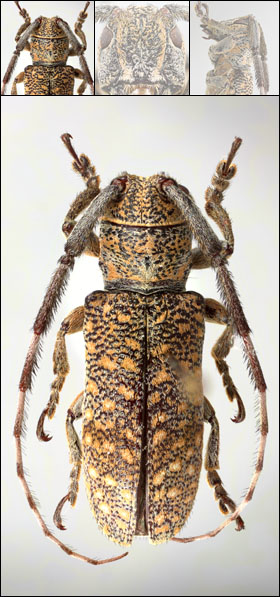 |
 Previous Genus Next Genus Previous Genus Next Genus 
Genus: Periergates
Diagnostic Features
- Description: Elongate-oblong, moderate-sized, ranging from about 14–17 mm in length. Integument generally dark brown, ferrugineous or black with whitish, ferrugineous, and ochraceous pubescence.
 Head with frons elongate, about as wide as width of four lower eye lobes; frons surface roughly sculptured or not. Eyes with lower lobes distinctly small, oblong to distinctly pointed apically. Genae elongate, distinctly taller than lower eye lobes. Antennal tubercles prominent, moderately to narrowly separated; tubercles not armed at apex or armed with a small projection; antennae about as long as overall body length, or as much as twice as long; scape gradually expanded to apex, about as long or longer than antennomere IV; antennomere III nearly straight or curved, about as long or longer than scape and longer than antennomere IV, densely fimbriate beneath; antennomere XI shorter than X (females) or longer than X (males). Pronotum transverse, roughly cylindrical to conical, distinctly narrower at base, with lateral tubercles. Elytra with sides roughly parallel; elytral apices jointly rounded; elytra generally uniform in coloration or speckled; base of elytra without tubercles or with two or more prominent tubercles at humeri. Basal 1/3 of elytra with dense punctation, surface granulate-punctate. Procoxae without projection or with an obtuse tubercle. Mesosternal process with apex subtruncate to feebly emarginate. Metafemora moderate to distinctly short in length, about 1/3–1/5 as long as elytra. Head with frons elongate, about as wide as width of four lower eye lobes; frons surface roughly sculptured or not. Eyes with lower lobes distinctly small, oblong to distinctly pointed apically. Genae elongate, distinctly taller than lower eye lobes. Antennal tubercles prominent, moderately to narrowly separated; tubercles not armed at apex or armed with a small projection; antennae about as long as overall body length, or as much as twice as long; scape gradually expanded to apex, about as long or longer than antennomere IV; antennomere III nearly straight or curved, about as long or longer than scape and longer than antennomere IV, densely fimbriate beneath; antennomere XI shorter than X (females) or longer than X (males). Pronotum transverse, roughly cylindrical to conical, distinctly narrower at base, with lateral tubercles. Elytra with sides roughly parallel; elytral apices jointly rounded; elytra generally uniform in coloration or speckled; base of elytra without tubercles or with two or more prominent tubercles at humeri. Basal 1/3 of elytra with dense punctation, surface granulate-punctate. Procoxae without projection or with an obtuse tubercle. Mesosternal process with apex subtruncate to feebly emarginate. Metafemora moderate to distinctly short in length, about 1/3–1/5 as long as elytra.
- The combination of the following characters will help to distinguish this genus: distinctly small eyes, widely separated; antennomeres III and IV densely fimbriate beneath; basal 1/3 of elytra with dense punctation, surface granulate-punctate; and elytra with sides roughly parallel.
- Similar genus/genera: strongly resembles Microcanus, Oncideres, and Taricanus.
Geographic Distribution
- Central America (Costa Rica, Guatemala, Mexico, Panama)
Host Plants/Trees
Girdling Behavior
- According to Lacordaire (1872), P. rodriguezi "...occasionally makes serious ravages in the coffee plantations by girdling the young branches of the trees."
Notes
Generic Synonymies
Selected References
|
 |
 
Periergates rodriguezi
♀ specimen
© E.H. Nearns
|
© 2011-2015 Nearns, E.H., Lord, N.P., and K.B. Miller
The University of New Mexico and Center for Plant Health Science and Technology, USDA, APHIS, PPQ.
|


